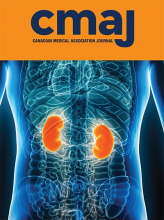As of today, CMAJ will no longer be publishing a news section1 and will no longer employ a lead of patient engagement. Over the course of this year, CMAJ Group will be winding down the publication of CMAJ’s sister journal, CMAJ Open. When our current editorial fellow’s term ends, CMAJ will not offer an editorial training position for the foreseeable future. These, and other decisions, were necessary because the Canadian Medical Association (CMA) recently informed the CMAJ Group’s publisher and me that our group’s 2023 budget would be cut dramatically as part of a refocusing of organizational priorities — as announced by the CMA on Mar. 1, 2023.2 My goal, as editor-in-chief of CMAJ, was to protect the integrity, quality and competitiveness of CMAJ within our disappointing new business reality.
This journal has been publishing news articles since 1978 and has long been recognized as a source of high-quality, independent health journalism. News content is popular, award-winning and often cited.1 During the first 2 years of the COVID-19 pandemic, online engagement with CMAJ news stories reached unprecedented levels as people sought reliable sources for up-to-date information. I am profoundly sad to lose news from CMAJ. Henceforth, our excellent journalists will move to work on a newly formed health news initiative within CMA since, in 2022, the CMA announced its intention to contribute “directly to media,” recognizing “the critical role of journalism in advancing debate and policy decisions.”3 Resourcing for this new project has been protected by the CMA for 2023
In 2020, under the editorship of Dr. Andreas Laupacis, CMAJ was resourced to embed patient engagement at the journal with the creation of the role of patient engagement lead; the incumbent did an excellent job fulfilling this remit over almost 3 years. Two new article types, “360 cases” and “In their own words,” have brought the voices of patients and caregivers to the pages of CMAJ, and these have been well received by readers. A panel of patient partners now advises editors, and CMAJ has piloted a system of patient peer review.4 The journal will be the poorer for losing its dedicated patient engagement lead; however, the journal will continue with a program of patient engagement and will still highlight the experiences of patients.
CMAJ Open — which celebrated its tenth year of continuous publication in January 2023, and is anticipating its first impact factor announcement — has been valued by Canadian health researchers as an important open-access home for their work that can directly support health system planning across the country. Since CMA’s announcement on Mar. 1, 2023,2 I and my colleagues have heard from many readers and researchers who have expressed disappointment at the closure of CMAJ Open.5 The decision to shutter this publication was not taken lightly. However, the size of the CMAJ Group’s budget cut made it necessary in order to continue to deliver a sustainable CMAJ. Readers may question why a research-only, online-only publication that charges publishing fees is not self-sustaining. Unfortunately, the fees charged by the CMAJ Group on acceptance of manuscripts do not come close to covering the full cost of publishing those papers, given the high standard of appraisal and editing applied. Compromising on ensuring the scientific integrity of the research published in CMAJ Group journals is not an option in this age of dangerous mis- and disinformation.
CMAJ, like most medical journals, is editorially independent but not financially independent. Although the journal earns revenue (i.e., from advertising and from publication fees for research and guidelines), it is financially dependent on its owner, the CMA. As the CMA has reassessed its priorities over the decades, funding for its publishing arm has fluctuated. As its editor-in-chief, I firmly believe that a strong, sustainable CMAJ that has the resources to adapt and innovate in its business environment should always be a top priority for the CMA. Robust scientific information forms an integral part of a well-functioning health system, alongside a healthy and adequate workforce, sufficient financial resources and appropriately functioning infrastructure — things for which the CMA is committed to advocating.6 CMAJ Open fulfilled that role too, allowing for the publication of well-conducted research that did not find a home in CMAJ.
Other effects of the recent business decision may be felt in months to come. A budget cut in the face of rising printing and postage costs means that print readers will see the content in their paper journals slightly reduced henceforth. Therefore, I strongly urge readers of the print version to sign up to receive CMAJ’s weekly table of contents email (https://www.cmaj.ca/email-alerts) so as not to miss out on articles that do not make it into print.
CMAJ is a public good — something that became abundantly clear during the COVID-19 pandemic, when the performance of both CMAJ and CMAJ Open were exemplary and traffic to CMAJ Group websites vastly increased. CMAJ’s impact factor more than doubled in 2022. One might expect that the owner of such high-performing and objectively valuable products would seek to increase rather than reduce investment in them. However, journals must answer to their owners in matters of business, and the cuts I have announced today represent the answer we were obliged to find to meet the CMAJ Group’s 2023 business reality.
Footnotes
Competing interests: www.cmaj.ca/staff
This is an Open Access article distributed in accordance with the terms of the Creative Commons Attribution (CC BY-NC-ND 4.0) licence, which permits use, distribution and reproduction in any medium, provided that the original publication is properly cited, the use is noncommercial (i.e., research or educational use), and no modifications or adaptations are made. See: https://creativecommons.org/licenses/by-nc-nd/4.0/











